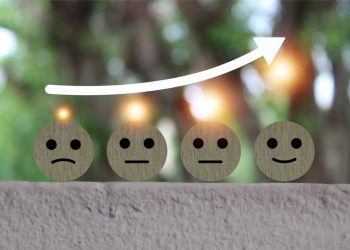By Julie Deardorff
RISMEDIA, Nov. 3, 2008-(MCT)-Chocolate cake is a popular home remedy for depression, but it comes with some unwelcome side effects. Sweet treats don’t just pack on the pounds; they give us a sugar high that’s inevitably followed by a demoralizing crash.
Still, there’s growing recognition in the medical community that the right food choices can improve your mood. Though drugs are often considered the first line of treatment for depression, a dietary change might be all you need, says James Gordon, a psychiatrist who advocates non-drug approaches to depression.
Gordon, a clinical professor at the Georgetown University School of Medicine, believes what we eat affects how we think and feel. “It’s a wake-up call to let us know our body is out of balance.”
Food can help restore that equilibrium, Gordon wrote in his new book, “Unstuck” (The Penguin Press, $25.95). The trick is knowing which key nutrients to include, and which foods to avoid.
Nutritional changes aren’t a magic bullet; they’re subtle pieces of a treatment plan that might also include therapy, exercise-one of the most effective depression busters-and stress-reduction techniques.
But “diet can help with virtually any chronic condition” including depression, said registered dietitian Wendy Bazilian, who holds a doctorate in public health. Just remember that major depression might require an integrative approach that uses food in conjunction with other therapies, including medication and counseling.
And never abruptly stop taking medication even if you’re experiencing side effects such as weight gain and sexual dysfunction; talk to your doctor about tapering down.
Eat more …
1. Salmon. Fatty, cold-water fish such as salmon contain omega-3 fatty acids, which keep cell membranes pliable and flexible, said neurosurgeon Larry McCleary, founder of a research group that looks at natural ways to treat health issues. It’s also in tuna, anchovies and sardines, but since fish fat is also a good place to store heavy metals, pesticides and poylchlorinated biphenyls (PCB), consider plant-based sources, including walnuts, flax seeds, pumpkin seeds and green, leafy vegetables.
2. Oatmeal, soy milk and two scrambled eggs. This meal will give you 500 milligrams of tryptophan, an amino acid that’s a precursor for the neurotransmitter serotonin, the brain’s feel-good hormone. Many antidepressants are designed to prolong the activity of serotonin in our cells, but you can actually increase the levels by eating carbohydrates (with the exception of fructose, the sugar in fruit), said Judith Wurtman, author of “The Serotonin Power Diet” (Rodale, $24.95).
3. Spinach: Low levels of the B vitamin folate, found in spinach, peas, navy beans, orange juice, wheat germ or avocado, may play a role in depression in some patients, said Brent Bauer, director of the Mayo Clinic’s Complementary and Integrative Medicine Program.
4. Vitamin D supplement. Vitamin D has been shown to help with seasonal affective disorder, said Bruce Hollis, professor of pediatrics at the Medical University of South Carolina. It may also have an anti-inflammatory effect and increase the flexibility of cell membranes, making the brain’s neurotransmitters work better. While primarily generated after the skin soaks up the sun’s ultraviolet B rays, Vitamin D can be obtained from oily fish and supplemented products like cow or soy milk and orange juice.
But Hollis says the recommended daily allowance-200 to 400 international units per day-is far too low. Instead, supplement with 2,000 IU’s or higher, especially between October and April for Chicagoans. At these levels, though, food isn’t a good option, since you’d have to drink a gallon of milk a day and no one needs those calories, Hollis said.
5. Broccoli and blueberries: When combined with protein in fish, chicken and turkey, high-fiber, non-starchy vegetables help stabilize blood sugar levels, said Jack Challem, author of “The Food-Mood Solution” (Wiley, $24.95). “Our moods usually track with blood sugar levels,” Challem said. “When our blood sugar is on the rise right after we eat, most people feel pretty contented. If it goes up too high, people feel sleepy because high blood sugar turns off orexins, a family of neuropeptides involved in feeling alert.” Superfruits such as blueberries are high in antioxidants, which are substances that absorb the free radicals produced by stress. Too many free radicals cause wear and tear on the body. Challem recommends green leafy vegetables, broccoli, cauliflower, raspberries, blueberries, blackberries, and kiwifruit.
6. Quinoa. Whole grains, a good source of B vitamins, break down and release sugar slowly, so you don’t get high levels of insulin and the ups and down of blood sugar, said Gordon. Quinoa, a seed that is classified as a grain, is considered one of the best sources of protein in the vegetable kingdom. Also try oats, brown rice, or whole wheat bread or pasta.
Eat less …
Red meat. As you increase omega-3’s, try to cut down on the other type of fatty acid, omega-6, which is found in beef. Though essential for brain health, omega-6’s are associated with promoting inflammation. Omega-6’s are also found in corn and vegetable oils.
Fried foods. Fat is a very important part of a cell’s membranes. But trans fats and saturated fats make the membranes rigid; then the neurotransmitters don’t work as well. Fried foods, hamburgers, french fries, butter, cheesecake, whole milk and beef are high in saturated fat. A product has trans fats if the ingredients list “partially hydrogenated oils.” Food manufacturers are allowed to list amounts of trans fat with less than 0.5 gram as 0 on the Nutrition Facts panel. To avoid it, read labels.
Gas station food. Processed foods contain refined flour and give you high doses of sugar but lack critical nutrients, said Gordon. “You’ll often experience a feeling of well-being from the sugar when levels are high, but when it’s low you experience a letdown or fatigue.” Refined sugars include white table sugar, white flour, high fructose corn syrup.
Alcohol and caffeine. Though alcohol is a stimulant in low doses, it also depletes the brain’s mood elevator, serotonin. Caffeine blocks the soothing effects of the brain’s “feel-good” messenger called GABA (gamma-amino butyric acid) that can calm mood and the digestive tract, said Molly Siple, author of “Eating for Recovery” (Lifelong, $17.95). “Refined foods and caffeine tend to raise the blood glucose,” she said. “The drop is a route into depression.”
© 2008, Chicago Tribune.
Distributed by McClatchy-Tribune Information Services.









